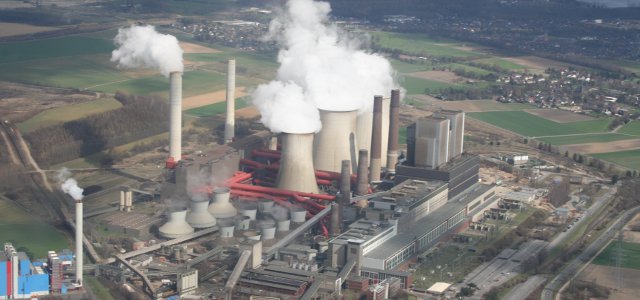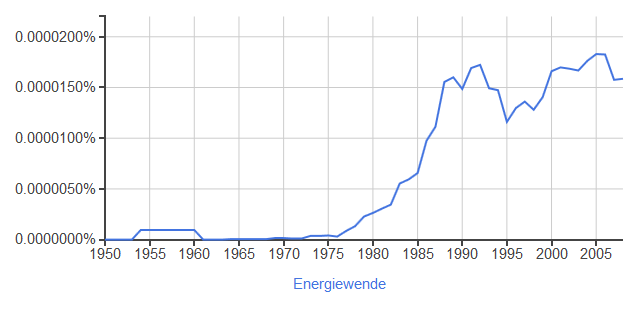In 1985, German researchers at a newly founded institute called Öko-Institut published a book called “The Energiewende is possible” investigating why no progress had been made since the original proposal five years earlier. Craig Morris says the book’s analysis can be summed up in one word: brilliant.

In the last century, a few big utilities dominated the German power production – bringing into existence the centralized power market structure as we know it today.
The book speaks to us from a far-gone era, in which monthly hookup fees for household electricity were based on the number of rooms in an apartment. Nowadays, all German households can switch power providers on a monthly basis and choose from different monthly connection fees. So is the 30-year-old book outdated?
Far from it. The book itself reviews the history of Germany’s energy sector back to around 1900 to “show how it can be changed and what interests have dominated.” The investigation is not just academic, but political: “We aim to encourage citizens to get involved in a ‘bottom-up energy policy’ and redesign for-profit energy supply in their interest.”

Google’s Ngram site shows the number of hits from its catalog of books. Above, we see how old the frequent use of the term “Energiewende” is in German books scanned by Google. After 1985, when the book reviewed here was published, the term really took off. (Source: Google)
The authors call for a “re-communalization strategy,” a new word at the time that has since become a main point of debate in the Energiewende – think of the recent campaigns for a citizen buyback of the local utility in Berlin (which failed) and Hamburg (which succeeded). This strategy is not merely about creating municipal utilities, but specifically part of divestment. It’s not enough for a municipality to run its own grid; the local utility also needs to divest from the big coal firms in order to do the right thing for its community.
RWE in particular is singled out in the book partly because of its special role as the owner of practically all of the lignite in western Germany. Such “vertical integration” is generally viewed with skepticism; after all, low resource prices from the coal fields made RWE an unfair competitor as a power plant operator. But starting with Germany’s Energy Management Act of 1935, the focus in Germany was on codifying the status quo in law so that the country could focus on military expansion (and after World War II, on economic expansion), not ensuring fair play in the power sector.
The economic necessities brought about by the focus on big business came at the cost of efficiency, however. The big utilities focused on big power plants, partly in order to overwhelm competitors. In 1964, a decree made it difficult for plants smaller than 300 MW to be built. By 1984, 80 percent of the country’s power plants were larger than 200 MW, compared to only 54 percent in 1962.
But as power plants grew in size, they also moved further away from consumers. Small plants located in towns can have their waste heat recovered for use in district heat networks, a process called cogeneration (of heat and power). Large plants further from consumption centers generally send their waste heat right up the cooling tower for no useful purpose. The big power plants have efficiencies of around 40 percent; cogeneration units, closer to 80 percent. Simply switching from big power units to small cogen would double the efficiency of this fossil fuel consumption, and we have not even started with renewables yet.
Why didn’t energy experts call for more cogeneration then? Many did, such as the authors of the book under review here. However, RWE and others managed to make not only the financial interests of municipal budgets synonymous with their own, but also with the personal finances of decision-makers. By 1929, RWE’s supervisory board was the largest in Germany with 108 members, 77 of whom were public officials (many of them mayors). The firm gave these folks cars, allegedly so they could come to the board meetings – at a time when few people had a car. It was a form of open corruption masquerading as a public-private partnership (PPP). Big firms were happy because they could pursue their business plan, and leading public officials were happy because they personally profited and could claim to be helping provide affordable, reliable power. No one told the public that the process was wasteful.
RWE also argued at the time that it also served the public’s interest, but the authors of the 1985 Energiewende book were not convinced. They argue that the board members representing municipalities did not have common interests (some had built up utility infrastructure, while others had not yet), so they never formed a single block on the board to oppose the firm’s business plans. In effect, RWE implemented the tactic of divide and conquer; the firm was able to play off one group of municipal utilities against the other in order to get its way. But the large representation of municipalities on the board allowed the firm to act as though it was following orders, not handing down its own decrees.
Critics of this arrangement called for full governmental control, but the authors argue that the debate between open market competition and state-run monopolies is misleading: “competition brings about monopolies.” Contrary to prevailing neoliberal thought in the Anglo world but in line with German social market economics (ordoliberalism), the authors correctly point out that free markets tend towards monopolies, so policymakers have to intervene to ensure fair competition. They also argue that competition is not the only goal worth pursuing. The book calls for a focus on environmental and social goals, which are not the main targets for-profit power providers, especially the corporate ones obligated to focus on short-term shareholder value.
Former US Labor Secretary Robert Reich recently included the myth of free market and government being opposites as one of the main three myths that needs to be cleared up. The 1985 Energiewende book focuses on clearing up that myth.
The authors do not, however, believe that municipal utilities always serve environmental and social goals better. By becoming dependent on dividends from big power providers, municipal governments found (and still find) themselves conflicted between the goals their community have and the revenue needed to reach those goals. What was good for RWE then became good for municipals and for Germany, to paraphrase a famous American.
RWE in particular urged municipal governments to become shareholders as a part of its expansion. The result was the German “concession fee,” a surcharge added to most power bills. Municipal governments use it to cross-subsidize public services, typically public transportation. In return, the municipality “concedes” all rights to power generation to the big utility. Essentially, firms like RWE offered potential small competitors a kickback in return for a monopoly. The authors estimate that the annual dividend from RWE for municipalities was around 16 percent on average in the 1960s and 70s. From the company’s beginnings in the early 20th century, RWE’s business strategy was not getting the best price or the best immediate return, but of shutting down competitors and becoming a monopoly.
Though the concession fee was used for a good purpose regularly (public services), it also entailed nefarious political lock-in; the fee means that divestment will hurt municipal services. It also historically represented a good example of the cost of cross-subsidies for big energy consumers being passed on to defenseless small consumers. The authors estimate that consumers who made up only 18 percent of total power consumption in the 1980s covered 98 percent of the concession fee. In my next post, I investigate these cross subsidies in greater detail.
The series reviews the 1985 follow-up book on the Energiewende study from 1980. That book was also reviewed here in 2013:
- Looking back at the Energiewende 1980 – 55 Percent Coal?
- Looking back at the Energiewende 1980 – Nuclear Cannot be Efficient
- Looking back at the Energiewende 1980 – Time for a Coal Phaseout
- “Efficiency lacks a loud lobby”: An interview with Florentin Krause
Craig Morris (@PPchef) is the lead author of German Energy Transition. He directs Petite Planète and writes every workday for Renewables International.
Thanks, dear Craig, for this article!
Will you write another one on the earlier 1980 book “Energiewende: Wachstum und Wohlstand ohne Erdöl und Uran” [Energiewende: Growth and Prosperity without Oil and Uranium] by Florentin Krause, Hartmut Bossel, and Karl-Freidrich Müller-Reissmann, also from the Oeko-Institut? The thinking that conceived the Energiewende, not in abstract but as a practical concept, started in the 1970s, in part inspired by Amory Lovins. The mental shift from opposing what is bad to thinking through what can and should be done better is the remarkable achievement of these thinkers, writers, and leaders of civic actions. It is a story worth telling!